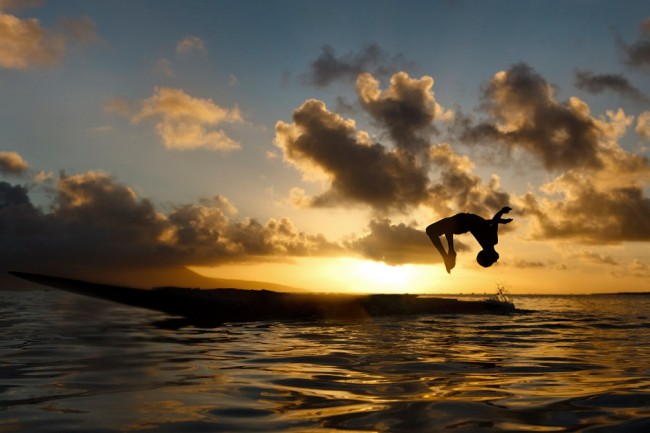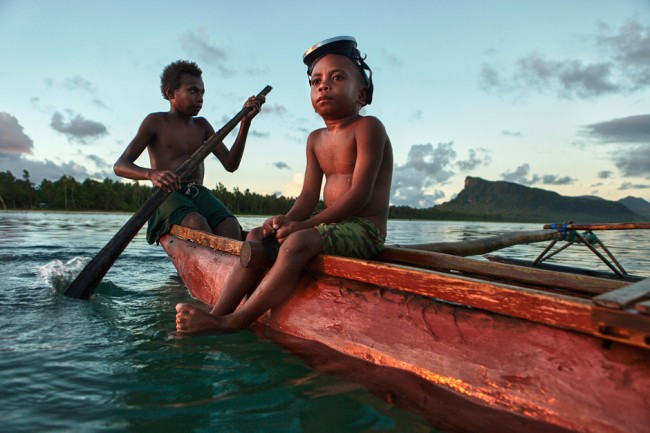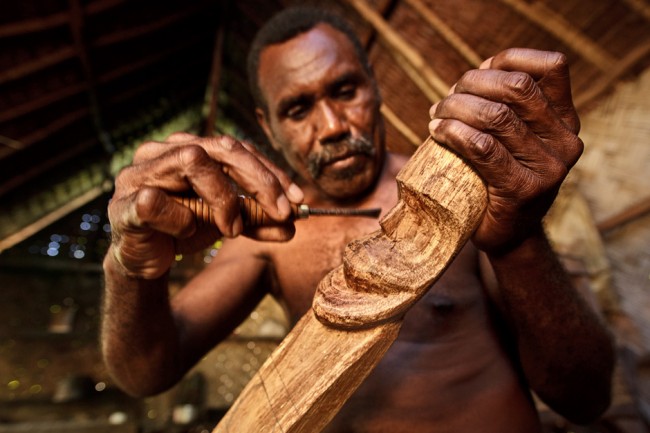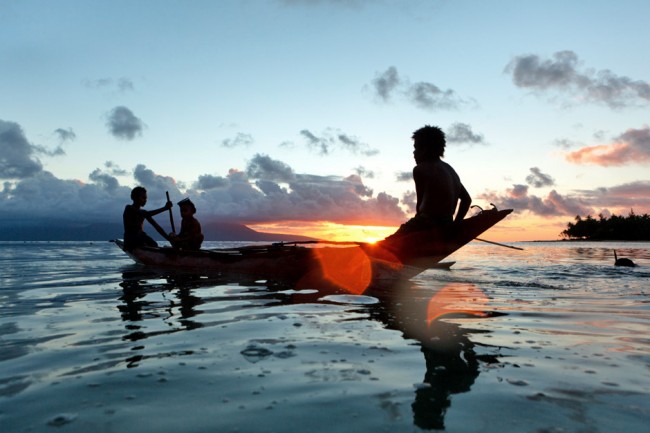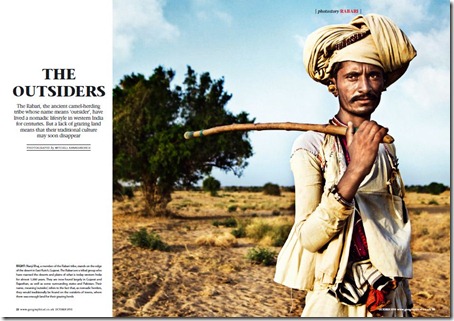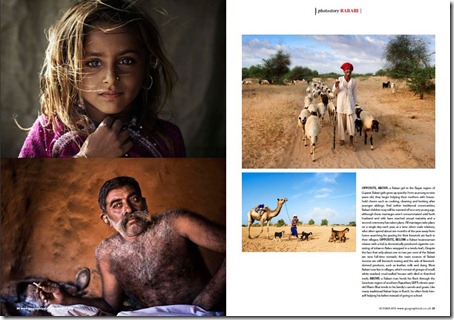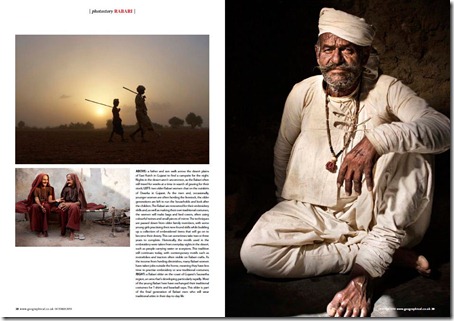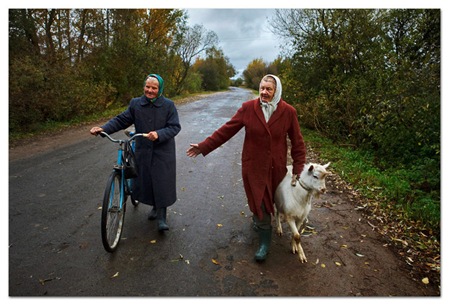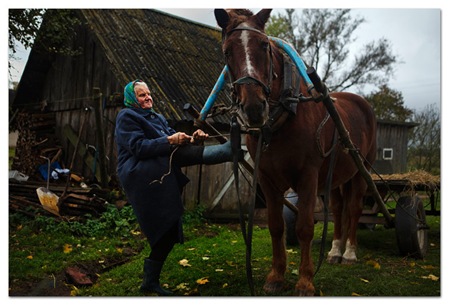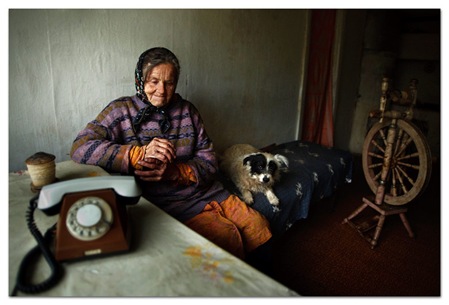Vast desert landscapes, nomads with weathered faces and blue robes, who fit the very definition of exotic, lots of sand and lots of camels! These describe my past week or so in Oulatta, a small desert town and home to this year’s cultural festival of Mauritania. As has often been the case through my African journeys so far, the last few days have been overfilled with excitement and awe, but also disappointment and frustration.
Mauritania, the Most Amazing Place You'll Probably Never Visit
Into the Heart of Ethiopia
Dramatic landscapes, kind, warm people and photographic inspiration at every corner - this was my romanticized vision of Ethiopia. Perhaps this vision was what made me all the more disappointed and emotionally deflated, when for over a month I came across more rudeness, dishonesty and overall strange treatment than anywhere else I had traveled. It took time and a lot of luck to meet the right people, to finally find the Ethiopia I dreamt of, but I have found it and, it is A-m-a-z-i-ng! I'll give you a bit of a background story to put things in perspective and then, to the photos.
Treasures in the Rock Mountains
The climb takes around forty-five minutes and it is literally a climb using your hands and feet for the last part of the journey. Holes in the vertical rock surface are what you use to keep yourself from falling off and to get to the top. As The "Lonely Planet" guidebook says, if you're scared of heights, "Don't look down!" Having a panic attack or"freezing" here would not be a good idea.
The Journey through Spain and Portugal
Fishermen of San Joaquin
I’ve spent the last three weeks in the small town of San Joaquin on Panay island in the Philippines. Due to my “activities” - the constant waking up in the morning and the fact that swimming in the middle of the sea, while going out with the fishermen can be rather physically demanding (for someone who’s not in the best shape) I’ve been too fatigued to write anything substantial during this time.
The city of Vigan and a video
I’ve left the cool Cordillera mountains for the warmth of the plains and a rather amazing city (more like town) by the name of Vigan. Vigan is supposed to have the highest amount of preserved colonial buildings anywhere in the Philippines and I have to say that these old Spanish/Mexican/Chinese/Filipino “relics” make the town very atmospheric indeed...
Close to Paradise
As I mentioned in my last post about Bob, my photography to assist tourism development continued in Rah Lava and to a lesser extent the bigger, neighbouring Mota Lava. The two islands belong to the very remote Banks group, they’re pretty much in the middle of nowhere, surrounded by endless stretches of the Pacific ocean. If you’re looking for a place to completely escape the busy, modern world and you like the sea, this is the place to escape to.
I’ve seen a lot of beautiful places over my travels and it’s not that easy to impress me anymore, however, I am a sucker for sea and mountains and whenever I find a place with both, well, I instantly fall in love. It’s not that I like to climb mountains, it’s that I love the sight of mountains rising over the sea. In my books it’s hard to come up with a better backdrop to a photograph than something like that. The beach and the lagoon at Rah Lava offered me those very kinds of backdrops, along with some fairly thick, lush greenery in the island’s interior. Besides the great scenery Rah Lava had something else to offer and that was some incredibly amazing (usually very expensive, but not here) seafood – I managed to live out my dream of eating lobster for breakfast, lunch and dinner (ok, I’m sick, I know, but it’s so tasty). Of course, to top it all off, as elsewhere in Vanuatu the people were absolutely wonderful. Quite naturally, I had to stay a while in Rah and I did, it was my longest stay in Vanuatu so far – two and a half weeks.
The reason I came to Rah was because George Thompson, the man I was helping out in South West Bay advised me to make the journey there and help out a man (in the same way – take photos for marketing) by the name of Luke Dini or Father Luke as he introduces himself (he’s a retired pastor). Both George and Father Luke were members of Vanuatu’s bungalow association, in fact they were probably the first two men to join a few decades back. The association was meant to set some sorts of standards for bungalows as well as service in those bungalows. The government was meant to help out and direct tourists to those places which were a part of the association.
It appears however that whatever project the government of Vanuatu undertakes, that project is destined for not fulfilling its potential and that has certainly been the case here. Father Luke opened his Bungalow in the seventies and he waited for fifteen years for the first foreign visitors, who happened to be a group of New Zeland Yachties needing to stay on land for just one night. After that there were no more tourists for another five years, but for whatever reason Father Luke didn’t abandon his idea of running a bungalow.
For years the place would receive just a handful of visitors a year, most of them - discount-seeking government workers who found the bungalow through the association (they seem to be the only people who turn to the association to find accommodation). From my understanding, the income was meagre, but Father Luke understood; for a small community like that of Rah Island, tourism was the only kind of business that would empower the locals and give them a chance to earn a decent enough income. Perhaps more importantly, it could keep the youth closer to home and this is a big thing, considering that many young, ambitious Ni-Vans leave remote places like Rah in search of jobs on the more developed Efate (where the capital Vila is) and Santo (where the second capital Luganville is located). Most often the youth come back, disillusioned, disappointed in their experiences in the world outside. The money they earn on the more developed islands is small in comparison to their sky-high expenses of living away form home. Things like food and accommodation are free for them, while they stay close to home in the huts that they build, near their gardens and the sea in which they know every fishing spot. In the outside world everything has a price tag and because of foreign investment and influence, things are pretty much out of reach for the regular citizen of Vanuatu.
When the youth come back to places like Rah after a disappointing tenure in the capital, they find themselves in an unusual situation. Having been exposed to the world of televisions, DVDs and night clubs they can’t look at life in a quiet island paradise without modern facilities in quite the same way. Sometimes they come back with new skills, which they can’t use because there are no industries of any sort. They’re left in-between two words, confused, a little frustrated and dreaming of what things would be like if their fortunes turned.
Father Luke had a vision, he felt that the presence of tourists on Rah could contribute to the entire community. Starting from the canoe-taxi across the lagoon from “mainland” Mota Lava, which every visitor must take to get to the bungalow, to the fishermen, lobster and coconut crab catchers who sold their catch to his the restaurant, to the traditional dance performers and so on. Everyone would benefit, everyone interested would have a chance to earn an income which was while fairly small, went a long way on an island like Rah. I was surprised that Father Luke was able to see such a big picture, this was very unusual for a man from a remote, forgotten island in the Pacific.
It turned out that Father Luke, besides being a Church pastor in the past, was a politician in the more distant past. In fact he was second in charge of all of Vanuatu during the colonial years and secretary to the president, once Vanuatu gained its independence. I was pleasantly surprised that Father Luke resigned from his high position because he strongly opposed the increasing corruption in the higher ranks of the government. It was then only at the beginning of its growth, these days the corruption in Vanuatu is legendary.
“My wife liked living the lavish lifestyle, having chauffers and eating in restaurants, so she didn’t want me to quit. I told her this; we can continue like that, but in a few years you will lose your husband, for I cannot stand living a lie, I’ll probably die from stress, from a heart-attack or something like that. I want to keep my dignity and to be able to look in the eyes of the people back home on Rah.” These were Father Luke’s words, to which his wife replied – “Let’s go home” meaning their modest house on Rah Island.
And so in some ways Father Luke is similar to George Thompson. He is a man who puts dignity and community above money and easy life. Thankfully, unlike George, after years and years of struggle things have taken turn for the better for Father Luke’s bungalows. They probably get close to thirty visitors a year on Rah Island and although the number does not seem impressive, it is when you consider the beginnings.
Since this is a photography and travel blog, I feel obliged to tell the readers about Rah Island as a travel destination, not only a photography destination. As I mentioned, it’s the ideal place to escape the hustle and bustle of the modern, developed world. It’s still not luxurious comfort living, but there is solar power, a shower and flush toilets – things that are not so common in the outer islands of Vanuatu. Father Luke’s bungalows are pretty cheap too, not South East Asia cheap, but fairly cheap by other standards. It’s about US$30 per person per day and that includes food, which after my recommendation will include more fresh fish and the possibility to eat lobster and coconut crab whenever your heart desires.
Ok, that’s enough of that. Let’s get to the photographs. The one above is of a local kid doing a back-flip from a canoe in the lagoon.
Saron returning from her family’s garden with the village dog. Vanuatu is one of the greatest agricultural societies on the planet, every family has a garden and every village family lives from one. The gardens are usually located somewhere in the bush and almost daily a family member will venture out there in order to tend to the crops or to bring some produce back home.
Silas and Young lobster hunting. The men look for familiar spots where they’re likely to find the crustaceans. The easiest time to catch them is during the moment of feeding, which lasts for approximately half an hour in the evening.
Silas putting one of the lobsters into the boat.
While on the subject of edible crustaceans, here’s another one – the legendary coconut crab. Near extinction in most of the world, the coconut crab is in abundance in lots of the Torba province, of which Rah and Mota Lava are a part. As you can see they grow pretty big, in fact according to Wikipedia, it is the largest-living arthropod on the planet. Those claws mean business too, Joseph is very experienced at catching and handling the creatures. Here some village youngsters watch him as he separates the coconut crab from his bate – the coconut.
As I mentioned in the last post, the men of Vanuatu are generally pretty amazing tree-climbers. By the time they’re teenagers they are strong enough to climb some crazy-big trees. David is one such teenager. As many other boys his age he climbs up trees to hunt (with a sling-shot) small birds and flying foxes, a delicacy in many parts of Vanatu.
Another image of Bob and his son Jeff. I wanted to include this one here just to emphasize the incredibly clear water around the reef. I’d dreamt about being in places like this for a looong time, now I feel like I’m getting a little spoilt.
The view out the front of the bungalow, just after sunset. Like I said, I’m a sucker for sea and mountains.
Dimitry (front) is one of Father Luke’s grandchildren. The kid is a CHARACTER, that’s for sure. He’s only four, but he’s very savvy, Tanya had to work real hard to become his buddy, he’s the type of kid who you have to constantly attract with something interesting. Dimitry is also unusually interested in his tradition (for a small child) he always tries to perform the island’s famous snake dance with the bigger boys and has a great sense for music and rhythm.
Franklin is a master wood carver, he creates some true masterpieces. Interestingly though, while Franklin learned the technique of wood-carving from his father, he learned how to carve more complex traditional works from photographs taken in a Museum of Pacific Arts somewhere in Europe. His ancestors sold a lot of the carvings to Europeans over a century ago and even the elders in his village (on Mota Lava) had never seen the carvings in the photographs.
Through a strange twist of fate, the “white men” who laid path for the destruction of the culture of the inhabitants of Rah and Mota islands over a hundred years ago also managed to save a part of it and to indirectly help revive the same part of that culture many decades later.
Franklin is a fascinating man and not only because of his determined approach towards wood-caring, it wasn’t unusual for him to go through five pieces of wood before getting things just right. Franklin is also a field worker of Vanuatu’s cultural centre, which means that he studies and records his own culture. Had I had more time I would have gladly spent hours chatting to the man, asking him endless questions.
The snake dance of Rah has become famous all over Vanuatu. It is usually performed at weddings and special occasions, but these days it’s become a regular performance for tourists too. I have to say that usually I think stuff like that is lame, but I’ve reconsidered that approach in Vanuatu and particularly with the snake dance. We watched it about 4 times and every time it was pretty cool.
A dancer having his body and face painted for the snake dance. I don’t know if anyone who is not part of the dance group has been behind the scenes for this dance before, back in the day seeing the preparation was strictly taboo. The paint used, as well as the material of the costumes were the performers’ secret and if anyone were to find out that secret they may have very well been killed, such was the kastom law.
A view from the rock of Rah, one of the most accessible high view points I’ve ever come across (you can get there in about 10 minutes from the village). No photograph will do it justice. From the rock you have a 360 degree of the surroundings and they are magnificent.
I couldn’t resist including another shot of children in a canoe in the lagoon. That place was ideal for photography – dramatic mountain backdrop on one side and the setting sun on the other, doesn’t get much better than that.
That’s all for now folks.
When hard work pays off
 A couple of months ago I got an email from an editor of British Geographical magazine telling me that my submission for a photo story on the Rabari (which I had actually submitted a year ago) was to be printed in the October issue of the magazine. A few days ago, when I returned from another trip to a remote part of Vanuatu I also received the news that they'd be using my image on the cover. Good news, I say, but let me share a little story that might be useful for some of you interested in having a career (if there's such a thing) in travel photography.
A couple of months ago I got an email from an editor of British Geographical magazine telling me that my submission for a photo story on the Rabari (which I had actually submitted a year ago) was to be printed in the October issue of the magazine. A few days ago, when I returned from another trip to a remote part of Vanuatu I also received the news that they'd be using my image on the cover. Good news, I say, but let me share a little story that might be useful for some of you interested in having a career (if there's such a thing) in travel photography.
In 2007 I travelled around West India along with my wife (then girlfriend) Tanya and my close Gujarati Indian friend Hardik. Our journey lasted for almost half a year. The aim of the journey was to photograph some of the last of the traditional Rabari people – the nomadic shepherds who have roamed the area for almost an entire millennia.
That particular journey was one of the most gruelling and challenging journeys of my life (ok, so I am not that old, but still). It was so difficult partly because it was the first serious project of my photographic career, partly because I had a motorcycle accident half way through and was very limited in movement for over a month, partly because the consequence of my limited movement made the project drag into the ridiculously hot months of West Indian summer (it got to 45C every single day) and finally it was difficult because the traditional Rabari were not all that easy to find, a lot of our time was spent on “field research”, arriving at certain destinations and having to ride (a motorcycle) hundreds of kilometers in some other direction because what we were looking for wasn’t there. I literally put blood, sweat and tears into that project, in fact so did Tanya and Hardik.
The project was funded by my previous print sales, cash from a wedding shoot that I'd done, some unemployment money I was able to save, as well as money I’d earned by working a few months in a photographic store just before the trip. Those were the days of struggle that undoubtedly all of us in the photographic profession go through at some stage (and I can only pray that I won’t have to go through them again).
The sole idea that I had for the images after the project would be finished was to have an exhibition. I was naive, thinking that an exhibition in Sydney could lift my status from a photographic nobody to somebody who could at least get an opportunity to keep making money doing what he loves. Perhaps I'd make a whole bunch of cash through print sales or somebody would notice my talents and hire me to shoot something, I thought. The outcome of the exhibition was a bit of a mixed bag. It was very successful in the sense that a lot of people came through the doors and saw my work, I even got some small critical appraise. However, it was a total failure as far as solving my financial problems – I sold three prints and one specially made album, which cost almost as much to produce as I sold it for. The cost of the exhibition and printing far outweighed the income I generated. I didn’t get a photographic job nor was I commissioned to shoot anything as a result of the exhibition either and so, by the end I felt a little doomed, like I was destined to go back to work in that photo store and to shoot weddings (no offence to those who do it professionally, it’s just not my thing).
Being fairly optimistic (and still naive), I didn’t let those thoughts pull me down for too long though. I realized that I was still at the very beginning of my journey and I had done something important - I laid a foundation for something good. Photographically it was very important that I had created a body of work that I could be proud of. I have always been and still am a firm believer in that for a photographer (especially at the start the journey) the goal of creating strong work should precede anything else. In the beginning a photographer should work for his photos and as the photographer’s career progresses the photos start working for him/her. This was the case with the Rabari project and the latest publication in Britain’s Geographical magazine serves as a nice reminder of this belief that I have.
The publication comes over three years after the project was finished and there were numerous others in between. While the exhibition didn’t help me achieve what I wanted, the result or lack of it gave me a good kick up the backside. I understood that my work wasn’t done and began to contact numerous magazines and entered into various competitions. The most notable of the results was me winning Australia’s Capture Magazine’s competition for best young photographer of the year for a selection of images from the project ( I got a $2000 camera as a result and sold it on eBay to help fund more future travels). Besides that I won a few other, smaller competitions for select single images and was published in quite a few photographic magazines (through which I sold more prints), one of which was the magazine where Kym, the enthusiast photographer who ended up going on my workshop in India (which I really enjoyed) found me. I have also licensed a number of the images from the series for various uses. All in all I have been rewarded quite well for my work, the rewards weren't instant, but they certainly came.
And so, what's the lesson here? There are a few of them, the first is that rewards do not always come in the shape or form that one expects them to. The exhibition, which I had put so much hopes into was nice in some ways, but the bigger rewards as far as exposure to a wider audience and income came from places I hadn't even really thought of. The next lesson is that creating a project or a series of images which can be used for various purposes seems to be the way to go these days. Don't put all of your eggs into one basket, it’s not like you shoot something for a big magazine, have your big pay-day and off you go on a spending spree, I have personally only heard of those days from some old-timers.
Above all that I have already mentioned though, I have written this blog post to remind and to encourage those talented photographers who might be a little discouraged with the way things are turning out for them or even feel totally lost at the moment. Remember the part about hard work. Remember also that creating truly worthwhile photography is what really matters at the end of the day. Remember that you might not be rewarded instantly, as I wasn't, but if you believe that your work is worth something, keep fighting for it, get it in front of editors, you don’t need any special connections or contacts for this, I simply sent emails and submissions to names I’d found on the internet or in magazines on the newsstands.
If you have put in the work, if you have something of value, you will eventually meet positive results – that’s the bottom line and that's the main point that I hope comes across from what I've typed here.
Ok, that’s about enough of that. The magazine goes on sale in October, probably only in the UK (though I may be wrong). Below are some screen grabs from the preview PDF which I was sent. I’m still in Vanuatu, but I am near the internet, so expect more posts and photos in the coming days.
The elders of Braslavschina
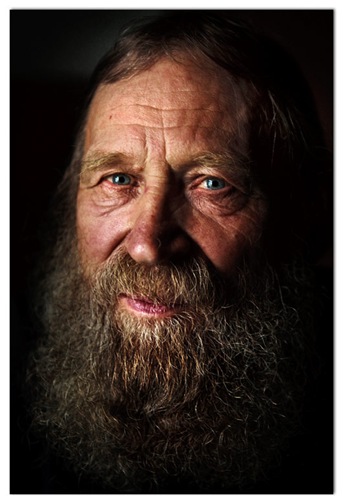 I am getting ready to drive from Belarus to Romania via Poland, Slovakia and Hungary, but here’s a post before I go.
I am getting ready to drive from Belarus to Romania via Poland, Slovakia and Hungary, but here’s a post before I go.
I’ve said goodbye to Braslavschina, the region which I fell in love with over my time there. Well, it’s goodbye for at least a month and a half, not forever. :)
There are a few things which I absolutely love about Braslavschina, but it should come as no surprise that for a photographer of people the best part of any journey is the interaction with the locals. The locals I enjoyed interacting with in particular are the elders of Braslavschina, the fascinating men and women who despite living such tough lives, often even in their old age, remain so generally positive and even naive in the sense that they are pure of the cynicism that fills the world in which they live.
I often heard different variations of the same phrase from the older generation in Braslavschina. “Our lives used to be so difficult before, now everything is so much easier. It’s possible to really live now, pity there’s not much living left.” They would say this with a somewhat sad smile, but a smile nevertheless.
In any case, here are some of the elders of Braslavschina which I had the pleasure to meet and chat with.
We met these two ladies along the road. I simply couldn’t resist the scene, stopped my car and approached this “trio”. I asked where they were heading and got a pretty hilarious reply - “We’re taking the goat to his girlfriend.” Said the woman in the dark coat. “Yes, we’re taking the goat so he can have sex”. Said the woman in red and giggled. It turned out that they were sisters and Yulia, the one in the dark coat, with the bicycle was a pretty fascinating character. We hung out with her a bit, talked and took some more photos.
Yulia is 76 years old, she used to work at the stables when she was young and says that she knows everything there is to know about horses. I was a little shocked when she lifted her leg like this to put the reigns on one of her own horses.
Speaking of horses, Edward was looking for two horses that his grandson had tied up somewhere in the area not far from his home. When I approached, he had actually mistaken me for one of those horses. At 86 he lost most of his sight and almost all of his hearing too. Not a good combination. I told him that his horses where nowhere in sight and then after driving ahead realized that they were about 200 meters behind a patch a location which Edward had no chance of arriving at by himself. We drove Edward to the horses, expecting that he wanted to take them home for the night. All the wanted to do however, was feed one of them apples and check that everything was fine.
Father Timothy, (also pictured at the top of the post) worked as an engineer in the government collective farming system most of his life. By chance he had learned some old Russian language as a child and remembered some prayers from the “Old Russian Orthodox Faith”. When the church father passed away, Timothy was approached by the local devotees to take on the responsibility of leading the prayers. After a year of studying (at the age of 65) and leading prayers he was blessed by the “Old Russian Orthodox” Church and sworn in as a Father himself. We had a good chat with Father Timothy, what impressed me most about him was his openness and lack of religious fanaticism. He said: “What happens in the afterlife? I doubt that anyone of us will know the answer while we’re here. I always say that the most important thing is to lead a decent life, and the rest will take care of itself.”
Though we spent almost an hour chatting to this kind old lady, we never got her name. The wheel in the corner is still used for weaving and at the time of our visit she had actually begun to weave socks for her grandson who visited her every now and then. The dog on the bed is named “Bobik” that name is about the equivalent of Fido in the English-speaking world. She said that Bobik was lucky to be let in indoors. He quickly jumped on the bed and made himself comfortable. Good for me, I feel he adds to the shot.
That’s all for now folks. The next time you’ll hear from me, I’ll be…don’t even know where.
Braslavschina - The most amazing place you’ve never heard of
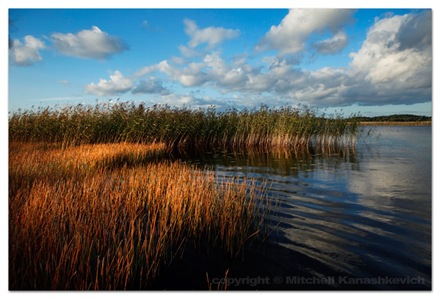 I have just returned from Braslavschina – the region around the town of Braslav and as I mentioned in my last post, all of my expectations have been surpassed. There are plenty of old, traditional villages, wonderful, photogenic people and there are over 400 lakes – almost all of them ridiculously picturesque.
I have just returned from Braslavschina – the region around the town of Braslav and as I mentioned in my last post, all of my expectations have been surpassed. There are plenty of old, traditional villages, wonderful, photogenic people and there are over 400 lakes – almost all of them ridiculously picturesque.
Perhaps it’s some sub-conscious thing about this region being a part of my “motherland”, but Braslavschina has quickly become one of my favorite places in the world. All I need to be happy is – something to photograph, some place to swim and some nice people to chat to. :) I can find all of that here, plus the kind of nature, which I only thought existed in fairy tales.
Ok, so I’ve fallen in love with this place, I really mean it. I’ve even enquired about prices of land and simple houses here and I have found out that they are ridiculously cheap, at least by Western standards. If I find something suitable, I’ll soon have my own tiny piece of paradise, perhaps even one right on a lake.
Anyway, enough dreaming. Here’s a brief look at what I’ve seen so far. I’m in Minsk for a few days to sort out some paperwork on my newly bought ‘84 Volskwagen Golf II. It ain’t pretty, but it’s cheap, it’ll take me where I want and it’s mine. I’ll be coming back to Braslavschina as soon as I can. I’ve only scratched the surface, as far as photography goes.
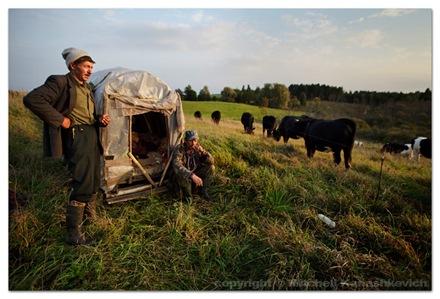 Tolik and Vatsik – two cow herders taking a break. It seems like I’ve got this strange attraction to cattle herders and fishermen, wherever I go. More on fishermen in the near future.
Tolik and Vatsik – two cow herders taking a break. It seems like I’ve got this strange attraction to cattle herders and fishermen, wherever I go. More on fishermen in the near future.
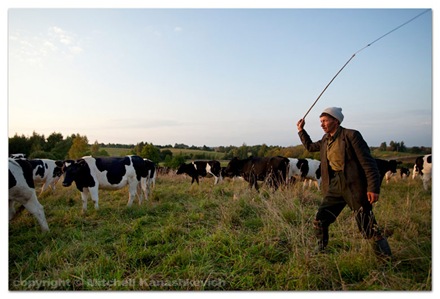 Tolik herding cows with a whip.
Tolik herding cows with a whip.
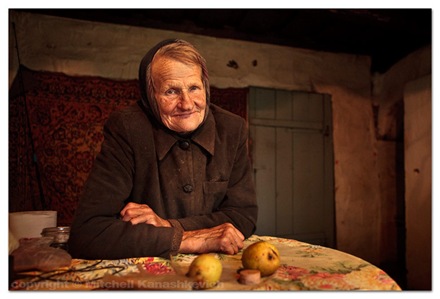 Above and below are images of kind elderly ladies from two different villages with the same story. In the really traditional villages there isn’t much youth these days and the old are the living, walking, breathing embodiment of the incredible history of this area.
Above and below are images of kind elderly ladies from two different villages with the same story. In the really traditional villages there isn’t much youth these days and the old are the living, walking, breathing embodiment of the incredible history of this area.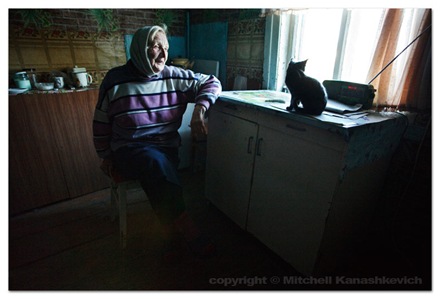
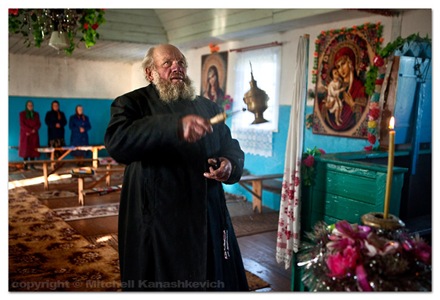 A prayer inside a church of the “Old Russian Orthodox” faith. It’s very similar to the “standard” Russian Orthodox religion, but all the prayer’s are written in ancient Russian and read accordingly. Only two people in this village can read them – this “Father” is one of them. The “Old Russian Orthodox” faith is almost extinct in Belarus. The three ladies in the background are basically the only attendees.
A prayer inside a church of the “Old Russian Orthodox” faith. It’s very similar to the “standard” Russian Orthodox religion, but all the prayer’s are written in ancient Russian and read accordingly. Only two people in this village can read them – this “Father” is one of them. The “Old Russian Orthodox” faith is almost extinct in Belarus. The three ladies in the background are basically the only attendees.
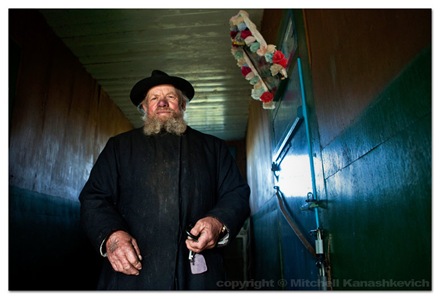 Father Akim (a very unusual name for Belarus) on his way out of the church.
Father Akim (a very unusual name for Belarus) on his way out of the church.
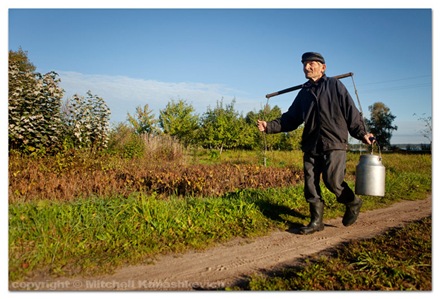 Every morning this man waits by the side of the road to sell is milk to large government-run co-operatives. Here he is returning home after selling the milk.
Every morning this man waits by the side of the road to sell is milk to large government-run co-operatives. Here he is returning home after selling the milk.
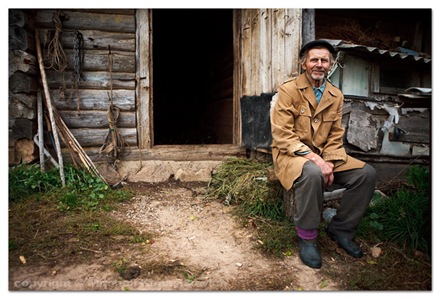 Grandpa Alexei was very shy about being photographed. When it comes to photos initial shyness is a common reaction amongst most of the older people. They’ll usually say something along these lines – “Why would you want to photograph me? I’m not shaven” or “I haven’t even got my teeth”. To me however these faces are amazing, they say so much without the need for words. After a short chat and me explaining what I do everyone usually agrees to have their picture taken.
Grandpa Alexei was very shy about being photographed. When it comes to photos initial shyness is a common reaction amongst most of the older people. They’ll usually say something along these lines – “Why would you want to photograph me? I’m not shaven” or “I haven’t even got my teeth”. To me however these faces are amazing, they say so much without the need for words. After a short chat and me explaining what I do everyone usually agrees to have their picture taken.
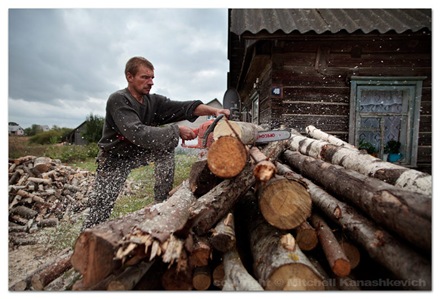 The modern way of preparing firewood – with a chainsaw. The man – Vasily is one the few younger men choosing to live his life in the countryside. He does however work outside of his village, on construction sites in cities as large and as far as Moscow.
The modern way of preparing firewood – with a chainsaw. The man – Vasily is one the few younger men choosing to live his life in the countryside. He does however work outside of his village, on construction sites in cities as large and as far as Moscow.
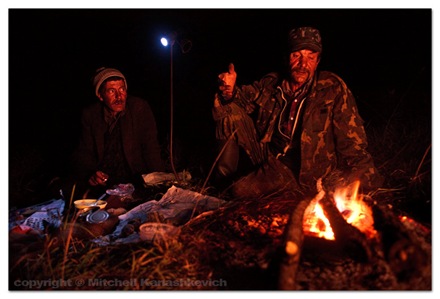 Back to the cow herders – Tolik and Vatsik having their dinner by the fire. I won’t mention what they were drinking.
Back to the cow herders – Tolik and Vatsik having their dinner by the fire. I won’t mention what they were drinking.
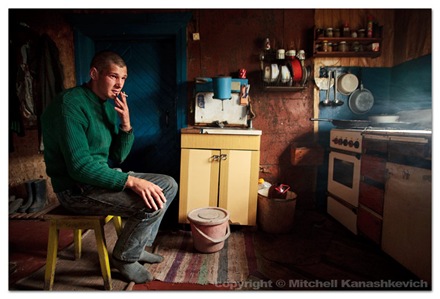 Vova is another rare find, he is the only young man in his village. The rest have moved out and now live and work in Belarus’ larger cities. Photographically speaking this is the sort of portrait I am enjoying shooting more and more these days - a shot where the person is surrounded by objects that tell you something about his her life/culture.
Vova is another rare find, he is the only young man in his village. The rest have moved out and now live and work in Belarus’ larger cities. Photographically speaking this is the sort of portrait I am enjoying shooting more and more these days - a shot where the person is surrounded by objects that tell you something about his her life/culture.
Ok, that’s all for now. Needless to say, I can’t wait to go back and shoot some more stuff. I have also filmed some interviews and some scenes that are best communicated through “moving pictures”, but unfortunately my ancient laptop isn’t powerful enough to edit HD video. Well, I guess that’ll all have to wait.
When alien worlds meet
I keep being reminded of just how different the world where I’m from is to the world where I now find myself. Perhaps no matter how many times I come to India things will always remain this way.For the past couple of days we’ve been trying to figure out how to make luggage carriers for my motorcycle. Getting involved in making anything in small town India often becomes a task of epic proportions - before long, everyone’s uncle’s, cousin’s son knows what you are doing. This can be good, as you can quickly track down the right people for the job, but quite often it is simply annoying – bored bystanders come to offer useless advice and opportunists try to cash in. After asking around we begin the search for a person who can do the job. The choice is very limited. Most of Junagadh’s inhabitants are very auspicious Hindus, many businesses are closed as the best time to re-open is on the fifth day after Diwali and that’s when we would ideally leave for our next destination. The first candidate for the job has his “office” - a wooden shack with a sewing machine next to a public urinal. I have to block my nose while I explain what we want. I’m thankful that he isn’t too interested - the smell is simply too much. The next candidate is much more pleasantly located – in a one-hundred-year-old courtyard, next to a Hindu temple. He is a pudgy, bald, mustached bag maker in his fifties – very welcoming and as it turns out very eccentric. He hands us his business card, which reads “NO GUARANTEES” in letters larger than anything else written on the card. He invites us to chat. Our conversation randomly detours, as conversations in India do, from the topic of bags, to feeding two hundred monkeys with three hundred rotis (a type of Indian bread) at the foot of the sacred Girnar Hill. That’s what the man does every Sunday and he proves it after insisting that we watch a VCD of this act. There is religious inspiration behind the man’s actions, but trying to understand his motives in depth is hard and I have long ago learned that understanding certain things in India can be bad for my sanity, I do not even try. After another change of topic it turns out that the monkey feeding bag maker is Hardik’s best friend Sandeep’s uncle. It is decided that he will make the luggage carriers, but the same evening Hardik rings to tell me that the man’s own nephew is not impressed with his work and does not recommend him. I remember “NO GUARANTEES” and think that perhaps it was put on the card for a reason. The next day we plan to buy the required materials and to meet the bag maker recommended by Sandeep, unfortunately the man isn’t keen on opening for business before the auspicious date and the plan is short lived. We decide to at least buy the materials and see what to do from there. Coincidentally Sandeep sells all the materials we require in his shop, but he too isn’t ready to re-open before the auspicious date. We turn to another option, to buy everything at the market, but suddenly Sandeep calls. He says that a client has pressured him to open early and this means that we can come by and get everything we need. When we arrive we see Sandeep standing outside of his shop with the rollers down. Five minutes pass, but Sandeep does not appear to be any closer to opening his shop. – Uh, em, why is the shop still closed? I ask. - I am waiting for the client. Sandeep replies through Hardik. – He should be here any minute. Knowing that in India ‘any minute’ can mean tomorrow or never I get edgy. – We are here and we are clients. So maybe Sandeep could open the shop? Hardik explains – We Hindus believe that once a shop is opened for the first time in the New Year a successful opening will mean a successful year. The first time the shop opens a sale must be made, we are not yet sure whether we will buy the materials in this shop. – Ok, we’ll definitely buy something. I say. – Oh, then it is ok! Hardik translates to Sandeep. The roller doors come up, Sandeep says a prayer and Tanya and I begin to look for something that we will definitely buy. Suddenly the client arrives, but Sandeep insists that we be the first to buy something, as we were first to arrive and our motives are supposedly more pure. We definitely need zippers and we take them to the counter. – How much for these two? – They are 7 rupees each, but I will charge 11 total, 11 is a lucky number. – Ok, whatever, great. Sandeep takes the money, says another prayer and now the other client can be served, while we pick out everything else that we need. – Hey, how much is this per meter? And this, and this? I enquire about a few items. Sandeep says something to Hardik in Gujarati, but I don’t hear numbers. – You cannot ask the price here. He is my best friend and you are like my brother, so this is like your shop. Just take what you need. Whatever the price will be, it will be the best price in town. I would have a hard time believing a line like this elsewhere, but Hardik is indeed like a brother. I know that young Indian men are very sensitive and as I simply want to get things done as soon as possible, I choose not to argue and go with the flow.
We got everything that we needed and in the end decided that we want to avoid drama and unexpected surprises. Tanya can make almost anything when it comes to working with fabrics, she will try to make the carriers herself using Sandeep’s sewing machine. As a result she is now out in the guesthouse’s communal hall, drawing up plans on the floor and cutting out pieces of fabric. I feel rather useless, the light is too harsh to shoot anything and I have already designed the carriers. I know that I will not have so much time in the near future and so I turn to typing this blog entry.

